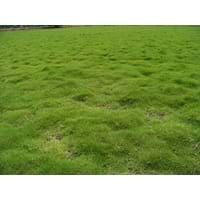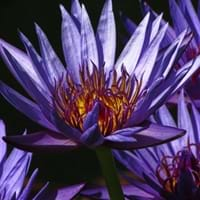Life Span
Perennial
Perennial
Origin
South-Eastern Asia, Asia
Eastern Africa
Types
Korean Lawngrass , Meyer Zoysiagrass , Manilagrass
Not Available
Number of Varieties
Not Available
Habitat
Lower slopes, Sandy stream banks
Lowland, Ponds
USDA Hardiness Zone
8-11
10-11
AHS Heat Zone
12 - 9
Not Available
Sunset Zone
H1, H2, 8, 9, 12, 13, 14, 15, 16, 17, 18, 19, 20, 21, 22, 23, 24
Not Available
Habit
Clump-Forming
Oval or Rounded
Minimum Width
Not Available
Flower Color
Green, Light Green
Blue, Dark Blue, Yellow, Yellow green
Flower Color Modifier
Bicolor
Bicolor
Fruit Color
Non Fruiting Plant
Light Green
Leaf Color in Spring
Light Green, Dark Green
Dark Green, Green
Leaf Color in Summer
Light Green
Dark Green
Leaf Color in Fall
Green, Yellow green, Gold
Green, Orange, Yellow
Leaf Color in Winter
Gold, Tan
Green
Leaf Shape
Grass like
Broadly Ovate
Plant Season
Spring, Summer, Fall, Winter
Spring, Summer, Fall, Winter
Sunlight
Full Sun, Partial Sun
Full Sun, Partial Sun
Growth Rate
Very Slow
Fast
Type of Soil
Loam, Sand
Clay, Loam
The pH of Soil
Acidic, Neutral, Alkaline
Acidic, Neutral, Alkaline
Soil Drainage
Average
Average
Bloom Time
Not Available
Early Spring
Tolerances
Drought, Salt, Soil Compaction
Pollution, Drought, Soil Compaction
Where to Plant?
Ground
In Water, Pot
How to Plant?
Sod, Sprigging or Stolonizing
Corms or bulbs, From Rhizomes, Seedlings
Plant Maintenance
Medium
Medium
Watering Requirements
weekly regular
Plant grows in water
In Summer
Lots of watering
Lots of watering
In Spring
Moderate
Moderate
In Winter
Average Water
Average Water
Soil pH
Acidic, Neutral, Alkaline
Acidic, Neutral, Alkaline
Soil Type
Loam, Sand
Clay, Loam
Soil Drainage Capacity
Average
Average
Sun Exposure
Full Sun, Partial Sun
Full Sun, Partial Sun
Pruning
Remove damaged leaves, Remove dead branches, Remove dead leaves
Remove damaged leaves, Remove dead branches, Remove dead leaves
Fertilizers
All-Purpose Liquid Fertilizer
All-Purpose Liquid Fertilizer
Pests and Diseases
Army-worms, sod webworms
Lily Beetle, Red blotch, Sap-Sucking Insects
Plant Tolerance
Drought
Drought
Flowers
Insignificant
Showy
Flower Petal Number
Single
Single
Foliage Texture
Fine
Not Available
Foliage Sheen
Matte
Glossy
Attracts
Crickets
Aphids, White bugs
Allergy
Not Defined
Diabetes, Nausea
Aesthetic Uses
Beautification, Cottage Garden, Farmland, Ground Cover, Landscape Designing
Beautification, Hanging Basket, Showy Purposes
Beauty Benefits
Not Available
Not Available
Environmental Uses
Provides ground cover, soil erosion prevension on hill slopes
Air purification
Medicinal Uses
Unknown
Anxiety, Combats Stress, Diarrhea, Improve circulation, increase memory, Soothing and relieving pain
Part of Plant Used
Whole plant
Leaves, Root, Stem
Other Uses
Used as a golf course turf
Oil is used in perfume, soaps, creams, etc., Traditional medicine, Used as Ornamental plant, Used for its medicinal properties
Used As Indoor Plant
Insignificant
Yes
Used As Outdoor Plant
Yes
Yes
Garden Design
Container, Edging, Groundcover, Lawns and Turf, Mixed Border, Rock Garden / Wall, Tropical
Bog Garden, Water Gardens
Botanical Name
ZOYSIA tenuifolia
Nymphaea caerulea
Common Name
Korean Velvet Grass
Blue Lotus, Blue Egyptian lotus
In Hindi
कोरियाई मखमल घास
ब्लू लोटस
In German
Korean Samt Gras
Blue Lotus
In French
herbe de velours coréenne
Blue Lotus
In Spanish
hierba de terciopelo de Corea
Blue Lotus
In Greek
hierba de terciopelo de Corea
Blue Lotus
In Portuguese
grama de veludo coreano
Blue Lotus
In Polish
Not Available
Blue Lotus
In Latin
Carl herba
Blue Lotus
Phylum
Angiosperms
Magnoliophyta
Class
Monocotyledonae
Magnoliopsida
Order
Cyperales
Nymphaeales
Family
Poaceae
Nymphaeaceae
Genus
Zoysia Willd
Nymphaea
Clade
Commelinids
Angiosperms
Tribe
Cynodonteae
Not Available
Subfamily
Chloridoideae
Not Available
Number of Species
Not Available
Season and Care of Korean Velvet Grass and Blue Lotus
Season and care of Korean Velvet Grass and Blue Lotus is important to know. While considering everything about Korean Velvet Grass and Blue Lotus Care, growing season is an essential factor. Korean Velvet Grass season is Spring, Summer, Fall and Winter and Blue Lotus season is Spring, Summer, Fall and Winter. The type of soil for Korean Velvet Grass is Loam, Sand and for Blue Lotus is Clay, Loam while the PH of soil for Korean Velvet Grass is Acidic, Neutral, Alkaline and for Blue Lotus is Acidic, Neutral, Alkaline.
Korean Velvet Grass and Blue Lotus Physical Information
Korean Velvet Grass and Blue Lotus physical information is very important for comparison. Korean Velvet Grass height is 2.50 cm and width Not Available whereas Blue Lotus height is 80.00 cm and width 40.00 cm. The color specification of Korean Velvet Grass and Blue Lotus are as follows:
Korean Velvet Grass flower color: Green, Light Green
Korean Velvet Grass leaf color: Light Green and Dark Green
Blue Lotus flower color: Blue, Dark Blue, Yellow and Yellow green
- Blue Lotus leaf color: Dark Green and Green
Care of Korean Velvet Grass and Blue Lotus
Care of Korean Velvet Grass and Blue Lotus include pruning, fertilizers, watering etc. Korean Velvet Grass pruning is done Remove damaged leaves, Remove dead branches and Remove dead leaves and Blue Lotus pruning is done Remove damaged leaves, Remove dead branches and Remove dead leaves. In summer Korean Velvet Grass needs Lots of watering and in winter, it needs Average Water. Whereas, in summer Blue Lotus needs Lots of watering and in winter, it needs Average Water.





